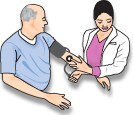|
Blood pressure (BP) is generated when blood is pumped through
your body, which exerts force against the inside walls of
your blood vessels. It is measured in millimeters of mercury
(mm Hg) - how
high the pressure can raise a column of mercury, and is based
on two numbers: systolic (pumping heart) and diastolic (between
pumps) BP.
"High-normal" BP, defined as a systolic pressure of 130 to
139 mm Hg and/or a diastolic pressure of 85 to 89 mm Hg, has
long been considered a safe range. Yet studies have shown
that very high BP is related to a higher risk for cardiovascular
disease. The authors of a recent study in The New England
Journal of Medicine asked the question: Are those with
high-normal BP also more likely to develop cardiovascular
disease?
 The authors examined data on nearly 7,000 adults in the Framingham
Heart Study. For the study, initial BP and cardiovascular
disease rates 12 years later were considered. The results
for those with high-normal BP are listed below: The authors examined data on nearly 7,000 adults in the Framingham
Heart Study. For the study, initial BP and cardiovascular
disease rates 12 years later were considered. The results
for those with high-normal BP are listed below:
Women were 2.5 times more likely and men were 1.6 times more
likely to have heart disease than those with optimal BP. Four
percent of women and 8% of men ages 35 to 65 with high-normal
BP had some form of heart disease, and older individuals with
high-normal BP were even more likely to have heart disease.
A quarter of those studied had high-normal BP.
If your BP falls within the high-normal range, you may not
be safe from cardiovascular disease. Have your BP checked
regularly, and be sure it falls within "normal" levels, especially
if you are elderly or diabetic.
Reference:
Vasan RS, Larson MG, Leip EP, et al. Impact
of high-normal blood pressure on the risk of cardiovascular
disease. The New England Journal of Medicine 2001:345(18),
pp. 1291-1297.
|



